Common Treatments
Topics on this page

Extractions
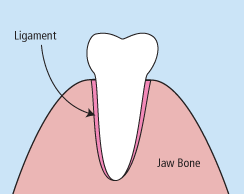 There are times when it is necessary to remove a tooth. Sometimes a baby tooth has misshapen or long roots that prevent it from falling out as it should, and the tooth must be removed to make way for the permanent tooth to erupt. At other times, a tooth may have so much decay that it puts the surrounding teeth at risk of decay, so the doctor may recommend its removal. Infection, orthodontic correction, or problems with a wisdom tooth can also require removal of a tooth.
There are times when it is necessary to remove a tooth. Sometimes a baby tooth has misshapen or long roots that prevent it from falling out as it should, and the tooth must be removed to make way for the permanent tooth to erupt. At other times, a tooth may have so much decay that it puts the surrounding teeth at risk of decay, so the doctor may recommend its removal. Infection, orthodontic correction, or problems with a wisdom tooth can also require removal of a tooth.
When it is determined that a tooth needs to be removed, your child’s dentist may extract the tooth during a regular checkup or may request another visit for this procedure. The root of each tooth is encased within the jawbone in a “tooth socket”, and the tooth is held in that socket by a ligament. In order to extract a tooth, the dentist must expand the socket and separate the tooth from the ligament holding it in place. While this procedure is typically very quick, it is important to share with the doctor any concerns or preferences for sedation.
Fillings
 Traditional dental restoratives, or fillings, may include gold, porcelain, or composite. Newer dental fillings include ceramic and plastic compounds that mimic the appearance of natural teeth. These compounds, often called composite resins, are typically used on the front teeth where a natural appearance is important. There are two different kinds of fillings: direct and indirect. Direct fillings are fillings placed directly into a prepared cavity in a single visit. Indirect fillings generally require two or more visits. These fillings include inlays, and veneers fabricated with ceramics or composites.
Traditional dental restoratives, or fillings, may include gold, porcelain, or composite. Newer dental fillings include ceramic and plastic compounds that mimic the appearance of natural teeth. These compounds, often called composite resins, are typically used on the front teeth where a natural appearance is important. There are two different kinds of fillings: direct and indirect. Direct fillings are fillings placed directly into a prepared cavity in a single visit. Indirect fillings generally require two or more visits. These fillings include inlays, and veneers fabricated with ceramics or composites.
Fluoride
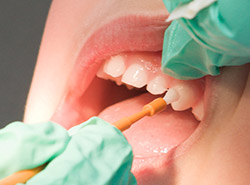 Fluoride is effective in preventing cavities and tooth decay and in preventing plaque from building up and hardening on the tooth’s surface. A fluoride treatment in a dentist’s office takes just a few minutes. After the treatment, your child may be asked not to rinse, eat, or drink for at least 30 minutes in order to allow the teeth to absorb the fluoride. Depending on your child’s oral health or the doctor’s recommendation, a fluoride treatment may be required every three, six, or 12 months.
Fluoride is effective in preventing cavities and tooth decay and in preventing plaque from building up and hardening on the tooth’s surface. A fluoride treatment in a dentist’s office takes just a few minutes. After the treatment, your child may be asked not to rinse, eat, or drink for at least 30 minutes in order to allow the teeth to absorb the fluoride. Depending on your child’s oral health or the doctor’s recommendation, a fluoride treatment may be required every three, six, or 12 months.
Mouthguards
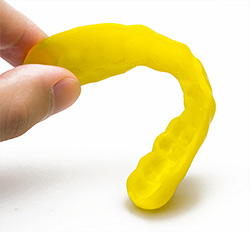 Whether your child wears braces or not, protecting his or her smile while playing sports is essential. Mouthguards help protect the teeth and gums from injury. If your child participates in any kind of full-contact sport, the American Dental Association recommends that he or she wear a mouthguard. Choosing the right mouthguard is essential. There are three basic types of mouthguards: the pre-made mouthguard, the “boil-and-bite” fitted mouthguard, and a custom-made mouthguard from the dentist. When you choose a mouthguard, be sure to pick one that is tear-resistant, comfortable and well-fitted for your mouth, easy to keep clean, and does not prevent your child from breathing properly. Your dentist can show your child how to wear a mouthguard properly and how to choose the right mouthguard to protect his or her smile.
Whether your child wears braces or not, protecting his or her smile while playing sports is essential. Mouthguards help protect the teeth and gums from injury. If your child participates in any kind of full-contact sport, the American Dental Association recommends that he or she wear a mouthguard. Choosing the right mouthguard is essential. There are three basic types of mouthguards: the pre-made mouthguard, the “boil-and-bite” fitted mouthguard, and a custom-made mouthguard from the dentist. When you choose a mouthguard, be sure to pick one that is tear-resistant, comfortable and well-fitted for your mouth, easy to keep clean, and does not prevent your child from breathing properly. Your dentist can show your child how to wear a mouthguard properly and how to choose the right mouthguard to protect his or her smile.
Sealants
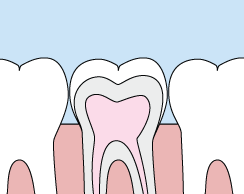 Sometimes brushing is not enough, especially when it comes to those hard-to-reach spots in your child’s mouth. It is difficult for a toothbrush to get in between the small cracks and grooves on your child’s teeth. If left alone, those tiny areas can develop tooth decay. Sealants give your child’s teeth extra protection against decay and help prevent cavities.
Sometimes brushing is not enough, especially when it comes to those hard-to-reach spots in your child’s mouth. It is difficult for a toothbrush to get in between the small cracks and grooves on your child’s teeth. If left alone, those tiny areas can develop tooth decay. Sealants give your child’s teeth extra protection against decay and help prevent cavities.
Dental sealants are a plastic resin that bonds and hardens in the deep grooves on your child’s tooth’s surface. When a tooth is sealed, the tiny grooves become smooth and are less likely to harbor plaque. With sealants, brushing your child's teeth becomes easier and more effective against tooth decay.
Sealants are typically applied to children’s teeth as a preventive measure against tooth decay after the permanent teeth have erupted. It is more common to seal “permanent” teeth rather than “baby” teeth, but every patient has unique needs, and your child’s dentist will recommend sealants on a case-by-case basis.
Sealants last from three to five years, but it is fairly common to see adults with sealants still intact from their childhood. A dental sealant only provides protection when it is fully intact, so if your child’s sealants come off, let your dentist know, and schedule an appointment for your child's teeth to be re-sealed.
Space Maintenance
If your child’s tooth has come out too soon because of decay or an accident, it is important to maintain the space to prevent future space loss and dental problems when permanent teeth begin to come in. Without the use of a space maintainer, the teeth that surround the open space can shift, impeding the permanent tooth’s eruption. When that happens, the need for orthodontic treatment may become greater.
Types of Space Maintainers
Space maintainers can be made of stainless steel and/or plastic, and can be removable or fixed (cemented to the teeth).
Removable
A removable space maintainer looks much like a retainer with plastic blocks to fill in where the tooth is missing. If your child is older and can reliably follow directions, a removable space maintainer can be a good option.
Fixed
Fixed space maintainers come in many designs.
A band-and-loop maintainer is made of stainless steel wire and held in place by a crown or band on the tooth adjacent to the empty space. The wire is attached to the crown or loop and rests against the side of the tooth on the other end of the space.
A lingual arch is used on the lower teeth when the back teeth on both sides of the jaw are lost. A wire is placed on the lingual (tongue) side of the arch and is attached to the tooth in front of the open space on both sides. This prevents the front teeth from shifting backwards into the gap.
In the case of a lost second primary molar prior to the eruption of the first permanent molar, a distal shoe may be recommended. Because the first permanent molar has not come in yet, there is no tooth to hold a band-and-loop space maintainer in place. A distal shoe appliance has a metal wire that is inserted slightly under the gum and will prevent the space from closing.
Caring for Your Child’s Space Maintainer
There are four general rules for taking care of your child’s appliance.
- Your child should avoid sticky foods, including candy and chewing gum.
- Encourage your child not to push or tug on the space maintainer with the fingers or tongue.
- Keep your child’s space maintainer clean through effective brushing and flossing.
- Your child should continue to see the pediatric dentist for regular dental visits.
Pulpotomy/Pulpectomy
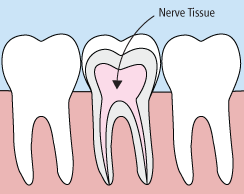
If your child’s primary tooth has extensive decay, or has been damaged by trauma, action may be needed to restore the integrity of the tooth and prevent infection from spreading to surrounding teeth. After a set of X-rays are taken, your dentist will be able to assess the extent of the infection and recommend one of two options, a pulpotomy or a pulpectomy.
Pulpotomy
If the decay or trauma is confined to the crown of the tooth, a pulpotomy may be recommended. When a cavity gets really deep, close to the pulp of a tooth, or even into the pulp, the pulpal tissue becomes irritated and inflamed. A pulpotomy is when the inflamed pulp chamber, usually on a baby molar, is removed. The dentist will remove all the infected material in the pulp of the crown only, leaving the living tooth root intact. After a pulpotomy on a baby molar, the empty space will be filled with dental cement and a stainless steel crown will be placed to restore the tooth.
Pulpectomy
If the infection involves tissue in both the tooth crown and the tooth root, a pulpectomy may be the best option. In a pulpectomy, the entire pulp material is removed from both the crown and the roots. After numbing your child’s tooth, the dentist will remove the pulp and nerve tissue from the crown and from the canals of the roots. Then, the pulp chamber and root canals will be thoroughly cleaned and disinfected. Next, the dentist will fill the tooth and tooth roots with a dental cement, and finish with a stainless steel crown.
Crowns
Crowns are “cemented” onto an existing tooth and fully cover the portion of the tooth above the gum line. In effect, the crown becomes the tooth’s new outer surface.
Stainless steel dental crowns are considered a good temporary restoration to save a primary tooth until the permanent tooth can erupt and take its place. Keeping the primary tooth if at all possible is very important. A primary tooth can be restored with a stainless steel crown during one appointment. A crowned tooth must be brushed and flossed just like other teeth.
Nitrous Oxide
Nitrous oxide, or laughing gas, is the most frequently used method for easing mild to moderate anxiety in children. Administered through a small mask that fits over your child’s nose, it is an effective way to calm anxiety. Your child will be asked to breathe through his or her nose and not through their mouth. As the gas begins to work, your child will become calm, although he or she will still be awake and able to talk with the dentist.
At the end of your child’s appointment, he or she will resume breathing regular oxygen, and all the effects of nitrous oxide will disappear. As your child gets older and becomes more comfortable during dental visits, nitrous oxide may not be necessary.

